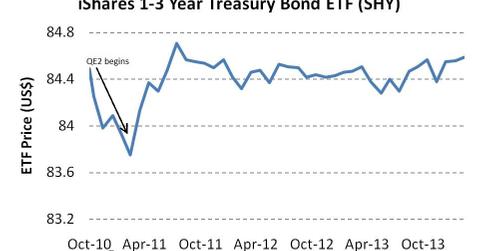Must know: How the Fed’s monetary policy affects short-term yields
The Fed directly influences the short-term yields by either buying or selling short-term Treasuries or affecting the Fed funds rate.
March 14 2014, Updated 2:53 p.m. ET

The chart below shows the effect of the Fed’s policy, QE2 in this case, on the iShares 1-3 Year Treasury Bond ETF (SHY). SHY tracks the Barclays Capital U.S. 1-3 Year Treasury Bond Index, an index that measures the performance of the short-term U.S. Treasury securities with maturities of one–three years. Another such short-term ETF is the Schwab Short-Term U.S. Treasury ETF (SCHO).(SHY)" src="https://media.marketrealist.com/brand-img/wp-content/0x0/uploads/2014/03/iShares-1-3-Year-Treasury-Bond-ETF-SHY-620x372.jpg" width="620" height="372">The dip in the chart after November, 2010, takes place right at the time when the Fed started its quantitative easing program. This resulted in more money being pumped into the economy, reducing the yields on its securities.
The Fed directly influences the short-term yields by either buying or selling short-term Treasuries or affecting the Fed funds rate.
Buying or selling short-term Treasuries
By way of its monetary policy, the Fed influences the short-term yields by regulating the money supply in the market. While enacting a monetary policy, if the Fed extensively starts buying short-term Treasuries, the yield on these securities decreases. So, the Fed is, in a way, pumping more money into the economy, increasing the supply of money available for financial activity, and reducing the borrowing cost. Similarly, if the Fed starts selling short-term Treasuries, it is reducing the money supply in the market; so, it raises the borrowing cost, including short-term yields.
In a rising rate environment, certain investors prefer to park their funds in ETFs that are designed to play rising interest rates, such as the SPDR Barclays Capital Investment Grade Floating Rate ETF (FLRN), which tracks floating rate debt of companies like Goldman Sachs (GS) and JPMorgan Chase & Co. (JPM).
Affecting the Fed funds rate
Another direct way in which the Fed influences the short-term yields is via changes in the Fed funds rate. The Fed funds rate is the interest rate at which banks lend funds to each other overnight. The Fed can directly influence this rate by simply signaling to the market that it’s going to either raise or lower the rate.
Since this short-term rate is directly controlled by the Fed, it establishes a very direct relationship between the monetary policy and the short-term yield curve. Even in case of securities with one month to one year tenure, the Fed is able to almost directly affect changes in the yield curves of these securities through its monetary policy. The Fed is in a position to directly affect the rates here, as factors like uncertainty over future inflation don’t come into play in such short durations. Plus, as these securities are extremely liquid and won’t lose much value if rates rise, there is a minimal risk premium that goes into these rates.
